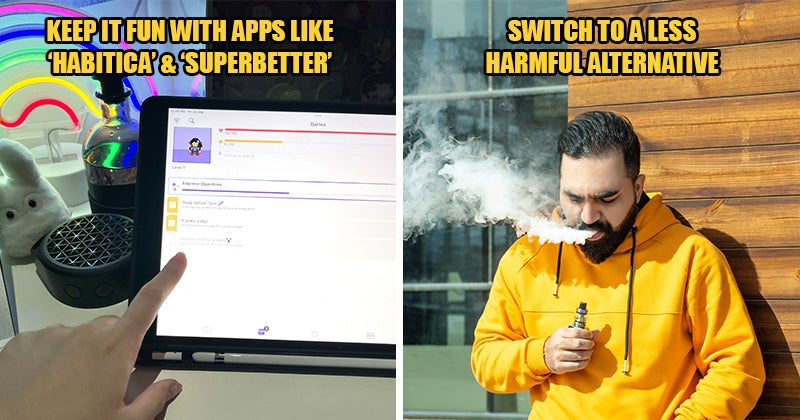Are there any bad habits that you would like to break? Well, you’re at the right place! Whether it’s overspending or nail biting, rest assured that there are scientifically proven ways to get rid of these habits for good.
Let’s dive into some effective methods you can try to break a habit, and don’t forget to tell us which approach suits you best!
1. Identify your triggers
Habits, no matter good or bad, can be broken down into three parts: cue (trigger), routine (the habit itself), and reward (e.g., satisfaction, happiness). Identifying and avoiding the triggers is one of the most effective ways to break the “habit loop”.
For instance, when you catch yourself overeating, try to find out why you do so. Are you stressed? Do you have an imbalanced diet? If you need a little more help, try using Ate, an app that helps record your triggers every time you eat so you can curb overeating!

2. Replace the bad habits with harmless ones
Studies have shown that suppressing bad habits might not be the best method to break them due to the higher possibility of a behavioural rebound. In other words, it is better to replace bad habits with other good or harmless habits.
Remember the third constituent of a “habit loop” aka the “reward”? Replacing bad habits works when the newly introduced habits offer similar rewards. For example, if you tend to bite your nails to relieve stress, try chewing gum instead!

3. Incorporate fun into your plan
When you first introduce a new habit into your routine, it can be challenging to make it stick. Consider incorporating fun into the new habit to make it easier and enjoyable!
Explore games that help you track your progress while you build a new habit, such as SuperBetter and Habitica. These games are designed to keep you motivated so that you look forward to completing your new routine!

4. Build a support system
Humans are social beings. We tend to rely on social connections for emotional and instrumental support. Therefore, having a strong support system contributes to better mental health, which can help ease the stressful and challenging process of breaking a bad habit.
Besides seeking support from your friends and family, you can also connect with people who face the same challenges. HabitShare, for example, is one of the social apps you can explore to befriend strangers and help each other out!

5. Look for less harmful alternatives
Some habits can be very challenging to break. One such habit is cigarette smoking, whereby smokers who are trying to quit may experience withdrawal symptoms like intense cravings, irritability, and insomnia.
To lower the health risks of smoking tobacco, smokers who want to smoke or wean off cigarettes can opt for less harmful alternatives (e.g., smoke-free alternatives like e-cigarettes/vape and heated tobacco products). This process of reducing smoking-related risks is also known as harm reduction.

The goal of harm reduction is to lower the negative effects of harmful behaviours. While harm reduction does not remove risks completely, it does aim to limit the consequences of our decisions on ourselves, society, and the environment.
A similar concept is used in the tobacco harm reduction (THR) strategy that reduces the health risks associated with using tobacco products.
How does tobacco harm reduction (THR) work?
Cigarettes release smoke and ash, which contain over 6,000 harmful chemicals. About 100 of these chemicals are found to cause smoking-related diseases like lung cancer, cardiovascular disease, and emphysema. These chemicals can also endanger the health of passive smokers who inhale cigarette emissions.
Instead of smoke and ash, the heating of tobacco or “vape juice” in smoke-free alternatives releases aerosol, which is comprised of water, glycerin, and nicotine. This makes smoke-free products less harmful alternatives for smokers who want to curb nicotine cravings.
Besides, by switching to smoke-free alternatives, smokers can also eliminate the presence of secondhand or thirdhand smoke that endangers the health of the people around them. This explains why switching to smoke-free alternatives is one of the ways to implement THR.

However, nicotine in smoke-free alternatives should not be overlooked. Despite not causing smoking-related diseases, it is still addictive and not risk-free.
Nonetheless, smoke-free alternatives are less harmful than cigarettes as they emit fewer harmful chemicals. It is hoped that smoke-free products would eventually play a significant part in building a smoke-free Malaysia.





































